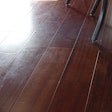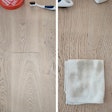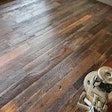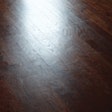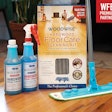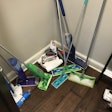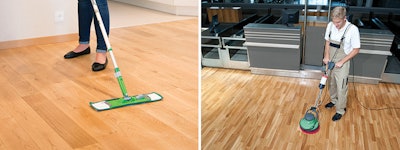
Wood finishes rely heavily on the correct application and appropriate maintenance to achieve best results. In this Q&A, Thomas Billermann, product manager for wood finishes at Osmo, offers end users and contractors advice on hardwax oils.
What are hardwax oils? What is the difference between them and water-based polyurethane?
Hardwax oils are combinations of oils and waxes. The oil content in the finish is absorbed into the wood, and the waxes form a protective layer on the outside. Contrary to hardwax oils, water-based polyurethane finishes lie on the wood surface and form a thick, hard layer that locks moisture into wood.
What are the benefits of hardwax oils for the wood and for end users?
Wood treated with hardwax oils can "breathe"—in other words, the natural moisture exchange can take place between the wood and its surroundings. This helps to extend the life of wood and improves air quality at home. Plus, wood flooring finished with hardwax oils does not develop an electrostatic charge, so it attracts less dust, lint and animal hair—great news for allergy sufferers.
Are there any disadvantages with a hardwax oil finish?
With time, hardwax oil finishes will wear away, and therefore they do require occasional refinishing.
How should end users maintain flooring treated with hardwax oils?
The maintenance required for floors treated with hardwax oils depends on the demands placed on it. In private households, normally mopping once a week is enough, and for high traffic areas in commercial interiors, such as restaurants, this should be done on a daily basis. End users should avoid using all-purpose cleaners, as they will strip away the protective surface. An oil-based cleaning concentrate is the better choice because it cleans and replenishes the oil content in hardwax oil finishes. Even with such cleaners, flooring will eventually get scuffed and start to look dull. Then it is time to use a wax-based cleaner, which not only cleans more intensively but also restores the protective wax layer. These cleaners can also be used on the spot for extremely worn and dirty areas.
When is refinishing necessary?
By using a wax-based cleaner, the intervals between re-oiling are extended. However, it is still necessary to re-apply a coat to flooring in private households every three to four years to ensure optimal protection. No sanding prior to recoating is required, but using an alkaline cleaner suitable for wood before the renovation is recommended. Also, spot repairs are possible on surfaces treated with hardwax oils. Just tape off the section to repair, sand away the damaged surface and refinish with two coats.
What about commercially used flooring? Does it need refinishing just as often?
Flooring in restaurants, shops and offices are used more intensively and face more wear and tear than in private homes. For these areas, an occasional coating with a fast-drying maintenance oil is recommended. Based on the amount of stress and traffic, a maintenance coat can be carried out more often or less. Normally the intervals for such maintenance coats are set in a cleaning and maintenance schedule. Maintenance coats are a cheaper and less labor-intensive alternative to a full recoat. Despite maintenance coats, occasional re-oiling with a hardwax oil is essential to preserve the optimal surface finish.



















